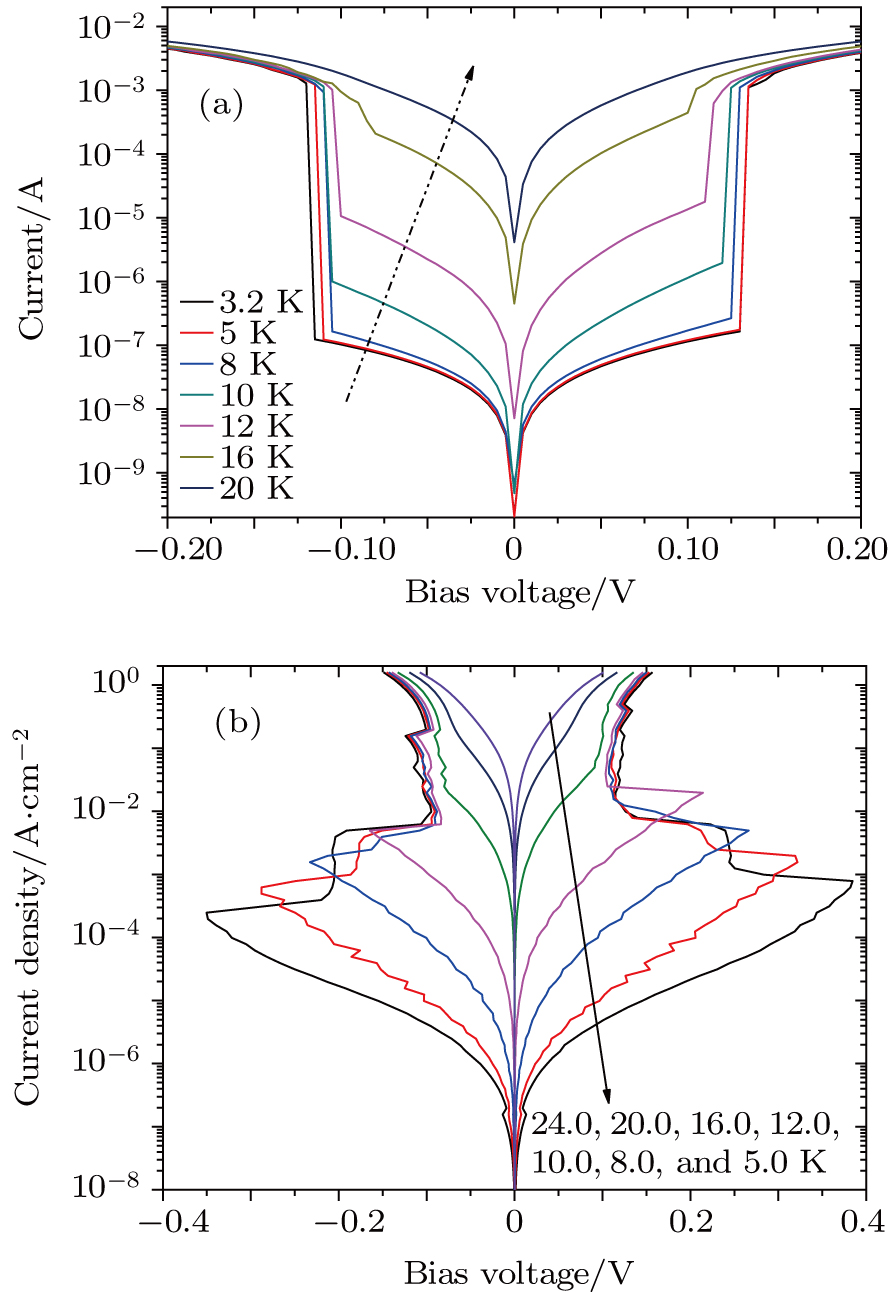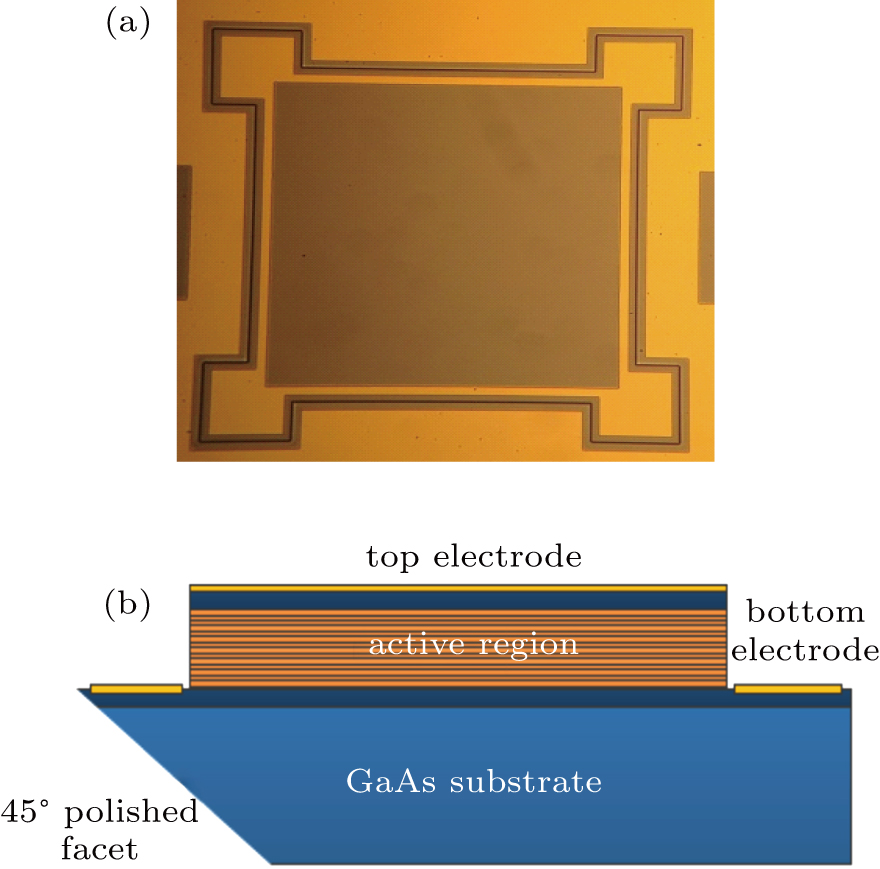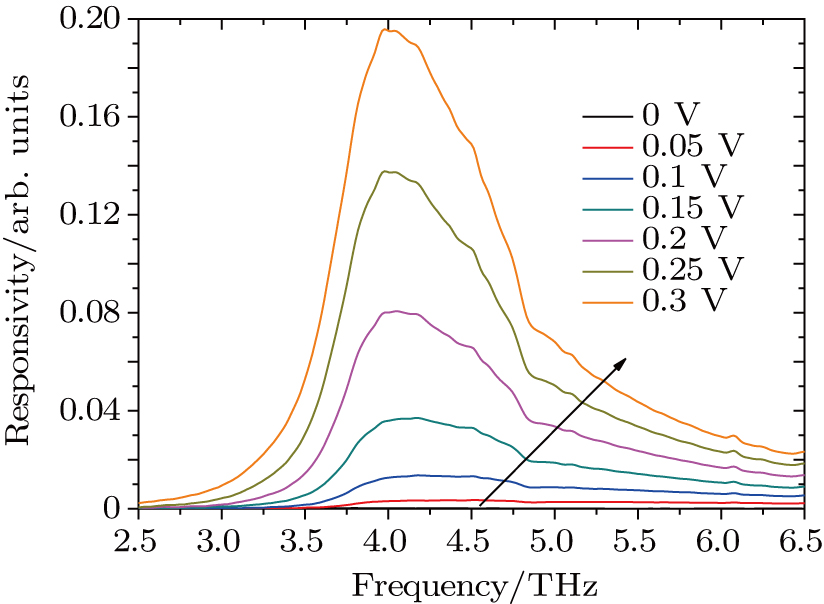† Corresponding author. E-mail:
We demonstrate a high performance GaAs/AlGaAs-based quantum-well photodetector (QWP) device with a peak response frequency of 4.3 THz. The negative differential resistance (NDR) phenomenon is found in the dark current–voltage (I–V) curve in the current sweeping measurement mode, from which the breakdown voltage is determined. The photocurrent spectra and blackbody current responsivities at different voltages are measured. Based on the experimental data, the peak responsivity of 0.3 A/W (at 0.15 V, 8 K) is derived, and the detection sensitivity is higher than 1011 Jones, which is in the similar level as that of the commercialized liquid-helium-cooled silicon bolometers. We attribute the high detection performance of the device to the small ohmic contact resistance of 
Terahertz quantum well photodetectors (THz QWPs) based on intersubband transitions extend the operation wavelength of quantum-well infrared photodetectors from mid-infrared to terahertz regime.[1–3] They are important components for terahertz imaging and terahertz free space communication due to their distinctive advantages of high sensitivity and fast response. The maturity of III–V compound semiconductor material growth and processing techniques makes it possible to fabricate high uniformity, excellent reproducibility, large area, and low-cost imaging arrays.[4–8] Additionally, due to the inherent short carrier lifetime, THz QWPs are very attractive in many high-speed applications.[9–12] The active region of QWPs, which consists of multiple-quantum-well (MQW) structures, can only respond to the light that satisfies the intersubband transition (ISBT) rules,[13–15] so the incident planes of the devices are usually polished to an angle of 45°.[16–18] Generally, the ohmic contact resistance of the THz QWPs is relatively high (
In this paper, we design and fabricate a high performance 4.3 THz GaAs/AlGaAs-based QWP device with the low ohmic contact resistance. We measure the negative differential resistance (NDR) phenomenon in the current scanning mode (in which the breakdown voltage is established). The photocurrent spectrum and blackbody response current spectrum at different voltages are tested. Based on the experimental results, the peak response rate is calculated to be 0.3 A/W (at 0.15 V, 8 K), and the derived detection sensitivity is higher than 1011 Jones, which is comparable to that of the commercialized liquid helium cooled silicon bolometers.[20]
The material is grown by molecular beam epitaxy on a semi-insulating GaAs substrate. Table 

| Table 1.
Epitaxial layer parameters of the 4.3 THz QWP. . |
The device is fabricated using the standard GaAs semiconductor processing techniques. Firstly, we use the photolithography to define the mesa size. Then the ion-coupled-plasma etching is employed to etch the active region to form an 

To facilitate the device characterizations at different cryogenic temperatures, the cleaved QWP mesa is mounted onto a cold figure of a liquid helium cooled cryostat. Within the cryostat with a high density polyethylene (HDPE) window, the electrical and optical characteristics can be recorded. The dark current characteristics can be measured in voltage and current sweeping modes using a high-precision power source. The photocurrent spectra are measured using a Fourier transform infrared spectrometer (FTIR) equipped with a broadband Globar source. In this measurement, the cryostat is placed in the sample chamber of the FTIR and the QWP device is at the focal point of the external terahertz beam emitted from the Globar source. The photocurrent signal is sent back to the FTIR for generating the spectra. A low noise current amplifier (SR570) with an amplification ratio of 200 nA/V is used to amplify the photocurrent at different bias voltages. The responsivities of the detectors are measured by using a calibrated blackbody source with a temperature of 1000 K and a numerical aperture of 0.2 inch.[21] The noise spectral density is measured using a spectrum analyzer and then the noise equivalent power (NEP) is derived from the responsivity and the noise spectral density.
Figure 
 | Fig. 2. (color online) Dark I–V curves measured in (a) voltage sweep mode and (b) current sweep mode at different temperatures. The mesa size of the terahertz QWP is 
|
It is worth noting that the breakdown voltage of the device can be higher than the kink voltage. In order to determine the breakdown voltage and observe the NDR phenomenon, we measure the I–V curves in current-sweeping mode as shown in Fig. 

The experimental photocurrent spectra at 5.0 K are shown in Fig.
The peak responsivity as a function of the bias voltage at different temperatures is depicted in Fig.
One of the most important characteristics of QWP devices is the detection sensitivity 

 |


 |

 |


| Table 2.
Detection sensitivity of 4.3 THz QWP at different voltages. . |
We designed and fabricated a high performance GaAs/AlGaAs-based QWP device with a peak response frequency of 4.3 THz. We measured the dark current, the NDR phenomenon, and established the breakdown voltage at current-sweeping mode. The photocurrent spectrum and the blackbody response current spectrum of the device were also recorded. Based on the experimental results, we calculated the peak response rate to be about 0.3 A/W (at 0.15 V, 8 K), and the detection sensitivity was measured to be higher than 1011 Jones, which is comparable to the commercialized liquid helium cooled silicon bolometer.
| [1] | |
| [2] | |
| [3] | |
| [4] | |
| [5] | |
| [6] | |
| [7] | |
| [8] | |
| [9] | |
| [10] | |
| [11] | |
| [12] | |
| [13] | |
| [14] | |
| [15] | |
| [16] | |
| [17] | |
| [18] | |
| [19] | |
| [20] | |
| [21] | |
| [22] |







